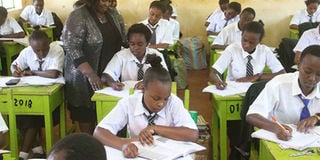The path to women’s right to education

While affirmative action has increased the number of girls joining higher institutions of learning, its downside is that girls generally opt for ‘soft’ courses. PHOTO| POOL | NATION MEDIA GROUP
When you get into a university lecture hall and more than half of the eyes looking at you are women’s, you realise Kenya’s education landscape has tremendously changed.
There was a time, not so long ago, when every university course boasted a handful of female students.
This turnaround was expected. There has been a sustained campaign to address and seal loopholes that led to the poor enrolment and retention of girls in school in an effort to bridge the gender gap in education.
The foundation stone for this mission was set in place in 2003 when the new National Rainbow Coalition government introduced Universal Free Primary Education and affirmative action.
AFFIRMATIVE ACTION
That year saw some additional one million pupils, a majority of them girls, enrol in primary school. And under affirmative action, female students joined the university at a point lower than the cut-off.
Since then, the mission of boosting girls’ education has become so aggressive that there were some complaints that the boy-child had been left – which is basically untrue as the numbers still show that the enrolment of boys in all institutions is generally higher by at least three per cent. For example, in 2017, enrolment for girls was 48 per cent compared to boys’ 52, according to the 2018 Economic Survey.
In ensuring all children went to school under the free primary education, local government administrators followed up on those who did not attend school in their locality to ensure 100 per cent attendance.
SCHOOL TRANSITION
Riding on this achievement, the government once again pushed for 100 per cent transition from primary to secondary school this year. The Education ministry says every child who sat the Kenya Certificate of Primary Education successfully transited to secondary.
To ensure this effort did not get deflated along the way, the country has entrenched policies and laws that safeguard the quest to achieve gender parity in education.
With the benefit of hindsight, non-governmental organisations and educators came up with solutions based on the challenges that kept girls out of school.
They identified menstruation and lack of sanitary towels as one of the biggest reasons girls struggled with school attendance, and eventually dropping out. During the menstrual cycles, girls from poor families kept away from school up to 40 days a year, affecting their performance.
This big issue was addressed in 2016 when Parliament passed the Basic Education Amendment Act and the President signed it into law in 2017.
Indeed this was not going to be possible without the 2010 Constitution whose Article 43 stipulates that ‘every person has the right to education’ . . . and that ‘every child has the right to free and compulsory education’ became mandator
SANITARY TOWELS
Distribution of free sanitary towels to girls in public schools started in August 2018 through the State Department of Gender Affairs with nearly four million girls benefitting.
The programme whose annual budget is nearly Sh0.5 million faced challenges last year when distribution hit headwinds and there were complaints about many girls not receiving the valuable item. Education CS George Magoha expressed his helplessness in changing the situation.
“Regrettably, the money to purchase these products is not under my control but I will continue to go and check and I will shout about it,” said Prof Magoha.
Prof Hellen Inyega, a literacy expert and lecturer at the University of Nairobi says the government’s deliberate effort to narrow the gender parity in enrolment of girls especially in tertiary colleges has borne fruits hundredfold.
“Girls are more confident about their capabilities; they are no longer afraid to go for what they believe in regarding education and career goals. Who knew sanitary towels would be distributed free to students and also be zero-rated? This should be applauded,” says Prof Inyega.
FORMAL EMPLOYMENT
However, she points out, in formal employment, men still hold the top positions/higher paying jobs.
But this situation post-education will not be for long. Trends show that women are gradually rising to take up the positions. It has become a norm now to specifically encourage women to apply for posts when vacancies arise.
Kenya and the world at large are purposely giving women a chance to excel in education. It is not an easy journey towards achieving gender parity in education and indeed other areas but gradually this will be met.
Although the free primary education and affirmative action have had a fair share of criticism about quantity versus quality, many agree that it was necessary to have these policies in place – and it is better to have an educated population than an ignorant one.
While affirmative action has increased the number of girls joining higher institutions of learning, its downside is that girls generally opt for ‘soft’ courses and avoid science-related courses such as engineering, says Dr Stella Onyiego, a senior lecturer at Moi University.
There are other spaces that have opened up in the last ten years to expand opportunities for girls to access education.
SCHOLARSHIPS
The Constituency Development Fund among other organisations that give scholarships, distribute bursaries to needy students without discrimination based on gender.
Also, the government’s heavy funding of Technical Vocational Education and Training Institutions (TVET) in the last few years has further opened educational opportunities for female students, who in the past had little options to pursue after failing to get the grade to join tertiary colleges.
Achieving gender parity is a long ride, but Kenya is on the right track. Just like Malcom X once put it, “Education is the passport to the future, for tomorrow belongs to those who prepare for it today.”
The policies on education in Kenya are preparing girls and women for tomorrow…and churning out Generation Equality in line with the global heartbeat.




